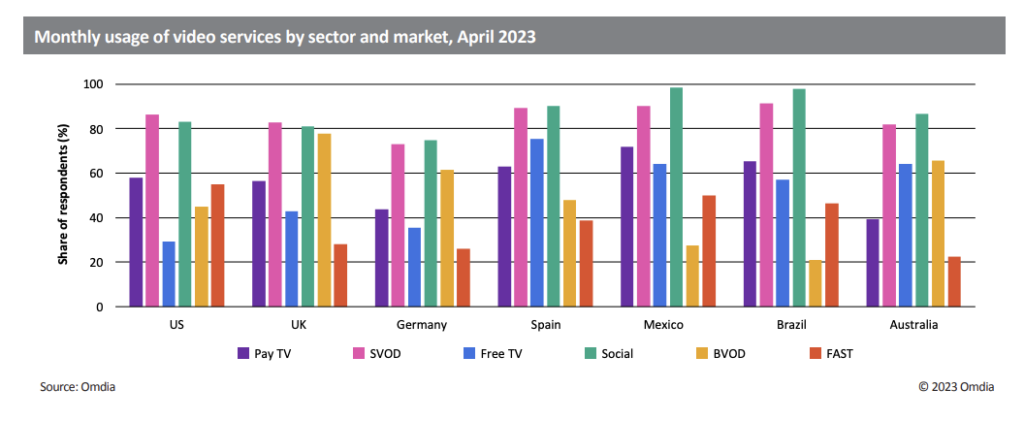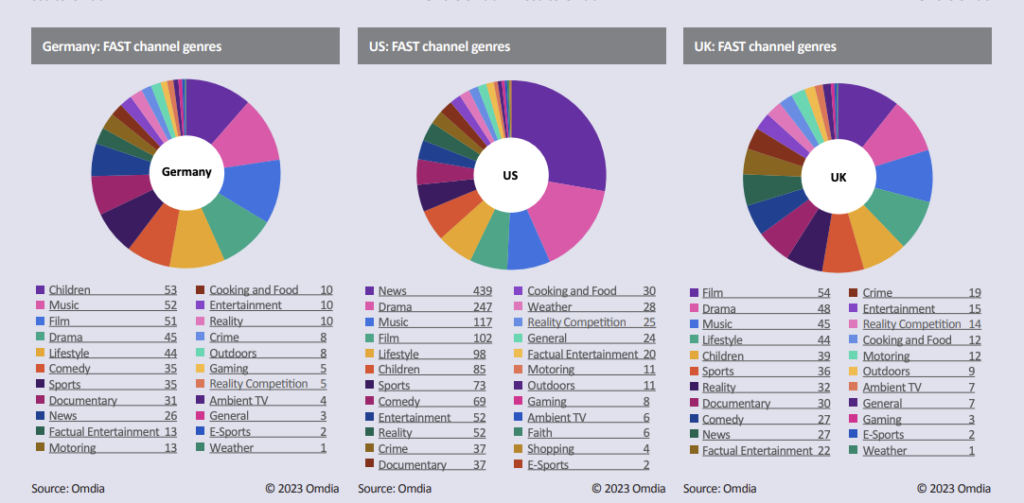
After more than 40 years of operation, DTVE is closing its doors and our website will no longer be updated daily. Thank you for all of your support.
DTVE Data Weekly: Finding fortune in frequent FAST users

Source: Omdia
FAST video services have cemented their position among mainstream video players, largely as a complementary video service alongside paid subscription video (both pay TV and online) and social video services.
According to the Omdia Consumer Research survey conducted in April 2023 across 12 international markets, the average user of FAST video services has almost three paid online video services and uses more than five other free or advertising supported video services. More than two-thirds of them also watch traditional free TV on at least a monthly basis. Furthermore, an average monthly FAST user claims to use around two different FAST services on average, typically composed of both a device related owned and operated FAST service, such as Samsung TV Plus or LG Channels, and a more device-agnostic service, such as Pluto TV or Rakuten TV.
The average FAST user is highly engaged with both ad-supported and paid video content, and these statistics are further amplified when considering more frequent users of FAST video—namely, weekly as well as daily users. As average usage rates increase, so do all related media engagement metrics. All users of FAST video services over-index across almost every media and entertainment consumer profile derived by Omdia Consumer Research, but the daily and weekly users go even further. Daily FAST service users are 20% more likely to be gamers than non-FAST users, 33% more likely to be mobile video users, and 50% more likely to be digital assistant users.

Source: Omdia
Another highlight of this heightened engagement is their preferences in content discovery. Perhaps counterintuitively, as FAST video service usage rates increase, their tendency to find content by flicking through channels/services and TV guides decreases, from around one-third of average consumers to around one-fourth of daily or weekly FAST video service users, depending on the market. Instead, they are more likely to discover content through recommendations by friends and family and through user interfaces or manual searches. These data points reflect the heightened engagement with media and entertainment already shown by FAST video users, as these consumers are more likely to know what content they want to watch and where they need to go to get it.
Depending on the market, FAST users are among the tail end of heightened video service engagement—certainly more so than their more ubiquitous free/ad-supported video counterparts from social, BVOD, and general AVOD services. This complimentary engagement avenue to these highly valuable users is unlikely to revolutionise their consumption patterns unless FAST services offer something more than their neighboring paid and free video services, many of which are already owned and used by their user bases.
The US is well ahead of the FAST field
The US is by far the most developed market, with 1,583 unique channels reaching some 134.1 million households. The UK and Germany are the next largest markets but are well behind in FAST channel numbers.
One reason for the plentiful numbers of channels in the US is the presence of local news and weather channels. Indeed, Weather Group Television is the most prolific FAST channel owner, with 214 channel brands. PlutoTV, now owned by Paramount Global, is not far behind, with 189 channels across these three countries.
As well as PlutoTV, other major players operating FAST channel platforms are consumer electronics companies manufacturers LG, Roku and Samsung, Amazon (under the Freevee brand), and Japanese conglomerate Rakuten. Genres on FAST range from classic TV staples like drama, comedy and children’s to more niche subject areas like extreme sports, cooking and gaming.
Max Signorelli, is Omdia’s principal analyst, Media & Entertainment